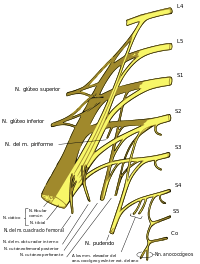Nerve plexus


A nerve plexus is a plexus (branching network) of intersecting nerves. Except for the ventral rami of Th2-Th12 nerves, they combine sets of ventral rami of spinal nerves that serve the same area of the body into one large grouped nerve. There are several in the body, including:
- Cervical plexus - serves the head, neck and shoulders
- Brachial plexus - serves the chest, shoulders, arms and hands
- Lumbar plexus - serves the back, abdomen, groin, thighs, knees, and calves
- Sacral plexus - serves the pelvis, buttocks, genitals, thighs, calves, and feet
- Celiac plexus (solar plexus) - serves internal organs
- Coccygeal plexus - serves a small region over the coccyx
- Auerbach's plexus - serves the gastrointestinal tract
- Meissner's plexus (submucosal plexus) - serves the gastrointestinal tract
Cervical plexus
The Cervical plexus (plexus cervicalis) is formed by the ventral rami of the upper four cervical nerves and the upper part of fifth cervical ventral ramus. The network of rami is located deep to the sternocleidomastoid within the neck. The cervical plexus innervates muscles of the neck and areas of skin on the head, neck and chest. The deep branches innervate muscles, while the superficial branches supply areas of skin. A long branch (C4; nervus phrenicus) innervates muscles of the diaphragm. Communications with cranial nerves vagus nerve [X.] and hypoglossal nerve [XII.] (nervus vagus et nervus hypoglossus) exist.
Brachial plexus
The Brachial plexus (plexus brachialis) is formed by the ventral rami of C5-C8-T1 spinal nerves, and lower and upper halves of C4 and T2 spinal nerves. The plexus extends toward the armpit (axilla). The roots of C5 and C6 form upper trunk (truncus superior), the ramus C7 forms the middle trunk (truncus medius), and the rami C8 and T1 join to form the lower trunk (truncus inferior) of the brachial plexus. Under the clavicle, the trunks (trunci) reorganize to form cords (fasciculi) around the axillary artery (arteria axillaris). The lateral cord (fasciculus lateralis) is formed by the upper and middle trunk, all three trunks join to form the posterior cord (fasciculus posterior), the lower trunk continues to the medial trunk (fasciculus medialis). The nerves (containing motor and sensory fibers) to the shoulder and to the upper limb emerge from the brachial plexus.
Lumbar plexus
Since the Lumbar plexus and Sacral plexus are interconnected, they are sometimes referred to as the Lumbosacral plexus. The intercostal nerves that give rami to the chest and to the upper parts of the abdominal wall efferent motor innervation and to the pleura and peritoneum afferent sensory innervation are the only ones that do not originate from a plexus. The ventral rami of L1-L5 spinal nerves with a contribution of T12 form Lumbar plexus. This plexus lies within the psoas major muscle. Nervi of the plexus serve the skin and the muscles of the lower abdominal wall, the thigh and external genitals. The largest nerve of the plexus is the femoral nerve. It supplies anterior muscles of the thigh and a part of skin distal to the inguinal ligament.
Sacral plexus
Ventral rami of L4-S3 with parts of L4 and S4 spinal nerves form the Sacral plexus. It is located on the posterior wall of pelvic cavity (pelvis minor). Nervi of the plexus innervate the perineal region, buttocks and the lower limb. The largest nerve of the human body, the sciatic nerve is the main branch, that give rami to the motor innervation of the muscles of the foot, the leg and the thigh. Common peroneal nerve and its branches innervate some part of the skin of the foot, the peroneal muscles of the leg and the dorsal muscles of the foot.
Coccygeal plexus
Coccygeal plexus originate from S4, S5, Co1 spinal nerves. (It is interconnected with the lower part of Sacral plexus). The only nerve of the plexus is the coccygeal nerve, that serves sensory innervation of the skin in the coccygeal region.
See also
Sources
- Henry Gray: Anatomy of the human body (Bartleby.com; Great Books Online)
- Richard S. Snell: Clinical neuroanatomy (Lippincott Williams & Wilkins, Ed.6th 2006) Philadelphia, Baltimore, New York, London. ISBN 978-963-226-293-2
- Eldra P. Solomon - Richard R. Schmidt - Peter J. Adragna : Human anatomy & physiology ed. 2nd 1990 (Sunders College Publishing, Philadelphia) ISBN 0-03-011914-6
- Jochen Staubesand (Ed.); R. Putz, R. Pabst, Johannes Sobotta: Sobotta Atlas of Human Anatomy I-II. (Urban & Schwarzenberg, München 1982) ISBN 3-541-72710-1
References
External links
- 06-095d. at Merck Manual of Diagnosis and Therapy Home Edition - Plexus disorders
Gallery
-

Anatomical illustration of the Brachial plexus with areas of roots, trunks, divisions and cords marked. Clicking on names of branches will link to their Wikipedia entry.
-

The Lumbar plexus and its branches
-

Plan of Sacral and Coccygeal plexuses.


